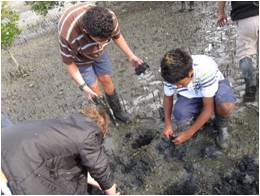 36 students were involved: 12 yr 3-7; 14 yr 8-10; 10 yr 11-13, supported by WBC coordinator Soozee McIntyre, 5 teachers/teacher aides and DoC ranger Denise Gillespie.
36 students were involved: 12 yr 3-7; 14 yr 8-10; 10 yr 11-13, supported by WBC coordinator Soozee McIntyre, 5 teachers/teacher aides and DoC ranger Denise Gillespie.
Some of the older students had experience of the Warawara Forest (which occupies the bulk of the catchment) through pig and possum hunting and have an interest in the connections between the health of the forest and the health of the waterways. This is a bi-lingual school with a strong focus on tikanga Maori and students and teachers have a special awareness of the principles of Kaitiakitanga – knowing that they are the primary guardians of the environment in this isolated Hokianga community.
 Much of the catchment is forested, with indigenous forest dominating the immediate catchment of the Whakarapa Stream (the waterway investigated) and some pine forest nearby. A narrow band of farmland and rural housing sits at the base of the forested range, with mangrove and saltmarsh estuary (Hokianga Harbour) immediately south of the school and settlement. The Whakarapa Stream is well vegetated throughout, apart from about 500m before it reaches the harbour, though even this has a fair amount of shading from a mixture of native trees and shrubs and the ubiquitous kahili ginger.
Much of the catchment is forested, with indigenous forest dominating the immediate catchment of the Whakarapa Stream (the waterway investigated) and some pine forest nearby. A narrow band of farmland and rural housing sits at the base of the forested range, with mangrove and saltmarsh estuary (Hokianga Harbour) immediately south of the school and settlement. The Whakarapa Stream is well vegetated throughout, apart from about 500m before it reaches the harbour, though even this has a fair amount of shading from a mixture of native trees and shrubs and the ubiquitous kahili ginger.
As a notably clean freshwater ecosystem, the Whakarapa Stream gave the students a chance to investigate the biodiversity values that can be observed in a relatively unmodified natural catchment. The aim of the investigation was for the students to gain an understanding of what constitutes a healthy stream and prompt further enquiry into how that stream health relates to the health of the Hokianga Harbour. The WBC programme was also to serve as a base for further study and action around maintaining and improving the health of the waterways of Warawara forest, in conjunction with DoC and the other communities that border Warawara.
Click here to see pictures and explanations of what they found during their stream experience.
 The objective was to extend the students and community understanding of the biodiversity values associated with the Whakarapa Stream and start them thinking about the bigger picture of the Warawara catchment as a whole and their role as kaitiaki.
The objective was to extend the students and community understanding of the biodiversity values associated with the Whakarapa Stream and start them thinking about the bigger picture of the Warawara catchment as a whole and their role as kaitiaki.
The schedule was changed a number of times as weather, tangi and other school events meant the postponement of planned activities. A December date for the field trip was finally fixed, only to be rained off, but as the traps had already been set I retrieved these and carried the critters and the clarity sample to the school for a ‘virtual field trip’ in the classrooms. With the new term in Feb 2013 we finally took the children to the stream.
All students participated in classroom activities to extend vocabulary relating to the freshwater environment, learn about fish and invertebrate identification and food webs of the forest and aquatic environments. Senior students produced beautiful artwork interpreting the mauri of the forest and awa.
The middle school students wrote accounts of their stream investigation experience to share with their community via the school newsletter - see link below.
 Senior students went on to participate in NRC’s Enviroschools pest control programme, inspired by their increased awareness of the connections between forest and waterway health. They have also been doing a follow-up study of wetlands with a focus on the estuarine environment.
Senior students went on to participate in NRC’s Enviroschools pest control programme, inspired by their increased awareness of the connections between forest and waterway health. They have also been doing a follow-up study of wetlands with a focus on the estuarine environment.
All the teachers remarked on the relevance of the material to their school, which is very much dominated by the natural environment and the appropriateness of the programme with its ‘hands on’ approach which suits the learning style of their students.
See the school newsletter for the enthusiastic accounts from the children.
